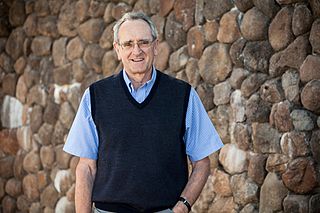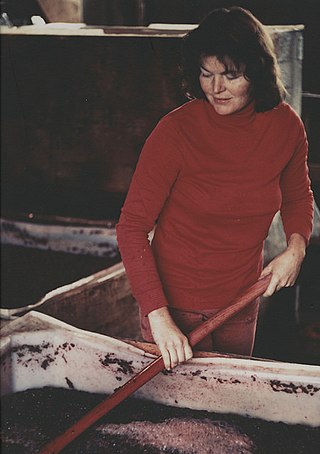Related Research Articles

Zinfandel is a variety of black-skinned wine grape. The variety is grown in over 10 percent of California vineyards. DNA analysis has revealed that it is genetically equivalent to the Croatian grapes Crljenak Kaštelanski and Tribidrag, as well as to the Primitivo variety traditionally grown in Apulia, where it was introduced in the 18th century, and Kratošija in Montenegro. The grape found its way to the United States in the mid-19th century, where it became known by variations of a name applied to a different grape, likely "Zierfandler" from Austria.
Oenology is the science and study of wine and winemaking. Oenology is distinct from viticulture, which is the science of the growing, cultivation, and harvesting of grapes. The English word oenology derives from the Greek word oinos "wine" and the suffix –logia the "study of". An oenologist is an expert in the science of wine and of the arts and techniques for making wine.
Warren Winiarski is a Napa Valley winemaker and the founder and former proprietor of Stag's Leap Wine Cellars.

Heitz Wine Cellars is a California wine producer located within Napa Valley east of the town of St. Helena. An early modern era Napa Valley presence and pioneering exponent of French oak, the estate enjoys a historical renown with the success of its Martha's Vineyard Cabernet Sauvignon, and has also been described as a "master of Grignolino".
The American Society for Enology and Viticulture, founded in 1950, is a non-profit, scientific wine production industry organization headquartered in Davis, California.

Mission grapes are a variety of Vitis vinifera introduced from Spain to the western coasts of North and South America by Catholic New World missionaries for use in making sacramental, table, and fortified wines. It is grown in South America, particularly in Chile and Peru, under then names Criolla and Pais. During the 19th century, the grape was known by several other names, including the Los Angeles grape, and the California grape.
The Department of Viticulture and Enology at the University of California, Davis, located in Davis, California, offers undergraduate and graduate degrees in the areas of grape growing and wine making. Located just 45 minutes from Napa Wine Country the department has strong connections with wine producers in California and elsewhere. The department has produced many of the notable winemakers of the California wine industry.
Napa Valley is an American Viticultural Area (AVA) located in Napa County in California's Wine Country. It was established by the Bureau of Alcohol, Tobacco and Firearms (ATF) on January 27, 1981. Napa Valley is considered one of the premier wine regions in the world. Records of commercial wine production in the region date back to the nineteenth century, but premium wine production dates back only to the 1960s.

St. Helena is an American Viticultural Area (AVA) located within Napa Valley, centered in and around the town of St. Helena, California. It was established by the Bureau of Alcohol, Tobacco and Firearms (ATF) on October 11, 1995, after the ATF received a petition from Mr. Charles A. Carpy, Chairman of the St. Helena Appellation Committee, proposing to establish a new viticultural area in Napa County to be known as "St. Helena."

California wine production has a rich viticulture history since 1680 when Spanish Jesuit missionaries planted Vitis vinifera vines native to the Mediterranean region in their established missions to produce wine for religious services. In the 1770s, Spanish missionaries continued the practice under the direction of the Father Junípero Serra who planted California's first vineyard at Mission San Juan Capistrano.

The Eola-Amity Hills AVA is an American Viticultural Area located in Polk County and Yamhill County, Oregon. It is entirely contained within the Willamette Valley AVA, and stretches from the city of Amity in the north to Salem in the south. The Eola and Amity hills cover an area west of the Willamette River approximately 15 miles (24 km) long by 6 miles (10 km) wide. The Eola-Amity Hills area benefits from steady winds off the Pacific Ocean that reach the Willamette Valley through the Van Duzer Corridor, a gap in the Oregon Coast Range, moderating the summer temperatures. The Eola Hills were named after the community of Eola, whose name was derived from Aeolus, the Greek god of the winds.
Precision viticulture is precision farming applied to optimize vineyard performance, in particular maximizing grape yield and quality while minimizing environmental impacts and risk. This is accomplished by measuring local variation in factors that influence grape yield and quality and applying appropriate viticulture management practices. Precision viticulture is based on the premise that high in-field variability for factors that affect vine growth and grape ripening warrants intensive management customized according to local conditions. Precision viticulture depends on new and emerging technologies such as global positioning systems (GPS), meteorologic and other environmental sensors, satellite and airborne remote sensing, and geographic information systems (GIS) to assess and respond to variability.
Christine Barbe is a French winemaker based in Napa Valley, California. She is known for producing wine from Sauvignon blanc grapes in the Pessac-Léognan style.

Henry Walker Crabb, also known as H. W. Crabb, Hiram Walker Crabb or Hamilton Walker Crabb, was an American wine cultivator, considered one of the pioneers of the development of the Napa Valley as a wine region. In the 1880s, his vine collection was one of the largest in the world.

Daniel Baron is an American winemaker. He is best known for his work with the Duncan family-owned Silver Oak Cellars and Twomey Cellars, and was Director of Winemaking for both. After his retirement in 2017, he launched Complant Wine with his son, Sam Baron, to produce small production, artisanal, single vineyard wines. Originally a field worker for John Rolleri at Chateau Montelena, he gained experience in the Bordeaux region of France and was mentored by the likes of grape geneticist Professor Harold Olmo, and winemakers Jean-Claude Berrouet and Justin Meyer. He became general manager of Christian Moueix's Dominus Estate in the 1980s. He became winemaker for Silver Oak, an exclusive Cabernet Sauvignon producer, in 1994, and was trained by Justin Meyer to follow in his footsteps as Silver Oak's winemaker before Meyer’s retirement in 2001. In 1999, Baron was instrumental in persuading the Duncans to establish Twomey to pursue Merlot, Pinot noir, and Sauvignon blanc after discovering high quality Merlot grapes on Silver Oak’s Soda Canyon Ranch Vineyard. He has served on boards such as the American Society of Enology and Viticulture and the Napa Valley Wine Technical Group.

Justin Meyer was an American vintner, enologist, and monk of the Christian Brothers. He was the founder along with Raymond Twomey Duncan of Silver Oak Cellars in 1972, a successful winery based in the Napa Valley and Alexander Valley. Today Duncan's sons David Duncan and Tim Duncan run Silver Oak Cellars, as well as Twomey Cellars, established in 1999. Meyer sold his share of the company to Duncan in 2001. One of California's top wine experts, he was president of the American Vineyard Foundation in the 1990s and also held numerous other positions in the wine industry. The San Francisco Chronicle cites Meyer as "one of the legends of the Napa Valley".
Zelma R. Long is an American enologist and vintner. She is considered to be one of the female pioneers in California wine, and was the first woman to assume senior management of a Californian winery, Simi Winery, of which she was president from 1989 to 1996. Long founded and was the first president of the American Vineyard Foundation to help finance research in enology and viticulture and also founded the American Viticulture and Enology Research Network (AVERN). She is the co-owner of Long Vineyards in St. Helena, California, and the Vilafonte Wine Estate in South Africa. Long has particularly been active in research into viticulture in Washington state.

Jean-Claude Berrouet is a French winemaker. World-renowned in his field and in Merlot production, he is best known for his work with Jean Pierre Moueix at the famous Chateau Petrus and Dominus Estate, also owned by the Moueix family. The Oakland Tribune considers Petrus under Berrouet to be "arguably one of the world's most revered and most expensive wines." He is known for making wines of subtlety and nuance that are considered the counterpoint of Michel Rolland.

Nancy Ponzi is a pioneer of the Oregon wine industry and the Oregon brewing industry, and the founder of Ponzi Vineyards, one of the Willamette Valley's founding wineries. She and her husband Dick Ponzi also established Oregon's first craft brewery, Bridgeport Brewing Company.

Jerome Julian Lohr (born January 1, 1937) is an American real estate developer, agriculturist, and winegrower. Lohr is the founder of J. Lohr Vineyards & Wines, a winegrowing, and winemaking company based in San Jose, California. J. Lohr Vineyards & Wines operates vineyards in the Paso Robles AVA in San Luis Obispo County, Arroyo Seco AVA in Monterey County, and the St. Helena AVA in Napa Valley, California. Lohr has earned a reputation as a pioneer of winegrowing on the Central Coast of California. The Jerome J. Lohr College of Engineering opened at South Dakota State University (SDSU) in June 2013 in his honor.
References
- ↑ Matasar, Ann B. (2006). Women of Wine: The Rise of Women in the Global Wine Industry. University of California Press. p. 90. ISBN 978-0-520-93070-4 . Retrieved 19 March 2013.
- ↑ "American Vineyard Foundation". Wines and Vines . Retrieved 19 March 2013.
- ↑ Patchell, Jerry (28 November 2012). The Territorial Organization of Variety: Cooperation and Competition in Bordeaux Napa and Chianti Classico. Ashgate Publishing, Ltd. p. 185. ISBN 978-1-4094-9004-3 . Retrieved 19 March 2013.
- ↑ Perdue, Lewis (1 June 1999). The Wrath of Grapes: The Coming Wine Industry Shakeout And How To Take Advantage Of It. Lewis Perdue. p. 55. ISBN 978-0-380-80151-0 . Retrieved 19 March 2013.
- ↑ Pinney, Thomas (7 May 2012). The Makers of American Wine: A Record of Two Hundred Years. University of California Press. p. 184. ISBN 978-0-520-26953-8 . Retrieved 19 March 2013.